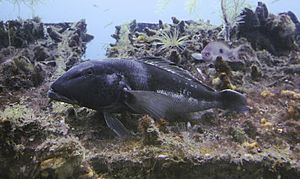Microcotyle constricta facts for kids
Quick facts for kids Microcotyle constricta |
|
|---|---|
| Scientific classification | |
| Genus: |
Microcotyle
|
| Species: |
constricta
|
Microcotyle constricta is a tiny worm that lives on fish. It is a type of monogenean, which means it is a parasite. Parasites live on or inside another animal, called a host, and get their food from it. This worm attaches to the gills of marine fish. It belongs to a family of worms called Microcotylidae.
Discovering Microcotyle constricta
Scientists give names to all living things, and this is called taxonomy. Microcotyle constricta was first found and described by a scientist named Robinson in 1961. He found it living on the gills of a fish called the New Zealand blue cod (Parapercis colias). He studied one worm to describe it.
Later, in 1965, two other scientists, Dillon and Hargis, studied 20 more of these worms. They added more details about the worm's mouth parts, where its reproductive organs are, and what its eggs look like.
What Does It Look Like?

Microcotyle constricta has a body shape similar to other Microcotyle species. It has a long, symmetrical body that is rounded at the front. The front part holds most of its important organs. The back part is called the haptor.
The haptor is also symmetrical. It has 74 to 82 rectangular clamps. These clamps are arranged in two rows, one on each side of the haptor. The worm uses these clamps to firmly attach itself to the gills of the fish it lives on.
At the very front of the worm, there are two oval-shaped suckers. These also help the worm hold on. Its digestive system starts with a mouth at the front. Behind the mouth is a rounded pharynx, which is like a small throat. Then comes an oesophagus, which leads to the intestine. The intestine has two main branches that spread out and have many smaller branches. The left branch even extends into the haptor.
Each adult Microcotyle constricta has both male and female reproductive organs.
Where Does It Live?
The main fish that Microcotyle constricta lives on is the New Zealand blue cod (Parapercis colias). This fish belongs to the Pinguipedidae family. The worm is found off the coast of New Zealand. Dillon and Hargis also found this worm on the same type of fish and in the same location.

